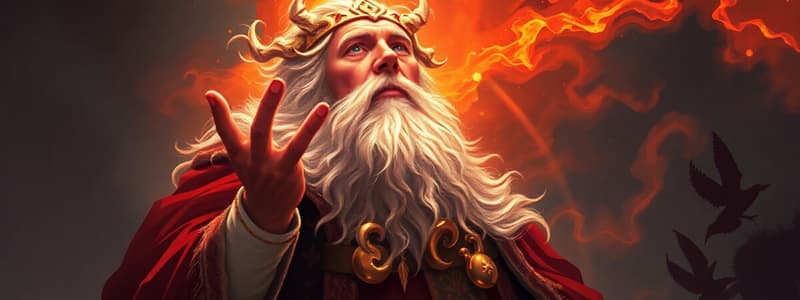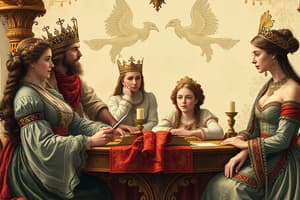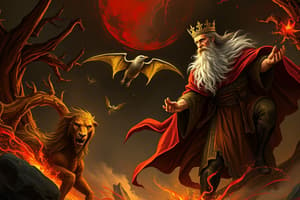Podcast
Questions and Answers
What does Lear's plea to keep his knights symbolize in terms of his identity?
What does Lear's plea to keep his knights symbolize in terms of his identity?
- His longing for past glories and honor.
- His desire for companionship and loyalty.
- His recognition of his lost authority and dignity. (correct)
- His need for validation from others.
Which line best reflects Lear's realization of his emotional turmoil?
Which line best reflects Lear's realization of his emotional turmoil?
- The tempest in my mind. (correct)
- My wits begin to turn.
- O, let me not be mad, sweet heaven!
- Blow, winds, and crack your cheeks!
What does Lear imply by stating, 'I am a man more sinned against than sinning'?
What does Lear imply by stating, 'I am a man more sinned against than sinning'?
- He believes he is a victim of circumstances. (correct)
- He refuses to accept any responsibility for his actions.
- He blames others for his downfall.
- He takes full responsibility for his mistakes.
How does Lear's statement 'You must bear with me. Pray you now, forget and forgive' illustrate his character development?
How does Lear's statement 'You must bear with me. Pray you now, forget and forgive' illustrate his character development?
What does Lear’s reflection, 'Poor naked wretches...O, I have ta'en too little care of this!' indicate?
What does Lear’s reflection, 'Poor naked wretches...O, I have ta'en too little care of this!' indicate?
What does Lear's desperate plea, 'O, let me not be mad, sweet heaven!' most directly convey?
What does Lear's desperate plea, 'O, let me not be mad, sweet heaven!' most directly convey?
What does Regan's dismissal of Lear's knights symbolize in the context of Lear’s authority?
What does Regan's dismissal of Lear's knights symbolize in the context of Lear’s authority?
Which statement best captures the essence of Lear's identity crisis?
Which statement best captures the essence of Lear's identity crisis?
What does Lear's quote 'I did her wrong' reveal about his character development?
What does Lear's quote 'I did her wrong' reveal about his character development?
How does the storm serve as a symbol in King Lear?
How does the storm serve as a symbol in King Lear?
What is the significance of Lear's reunion with Cordelia?
What is the significance of Lear's reunion with Cordelia?
Which quote best expresses Lear's moment of humility and self-awareness?
Which quote best expresses Lear's moment of humility and self-awareness?
What does Lear's regret regarding his past indifference signify?
What does Lear's regret regarding his past indifference signify?
What does the action of Goneril and Regan stripping Lear of his knights symbolize?
What does the action of Goneril and Regan stripping Lear of his knights symbolize?
How does suffering contribute to Lear's character development?
How does suffering contribute to Lear's character development?
What aspect of Lear's character does his decision to divide the kingdom primarily represent?
What aspect of Lear's character does his decision to divide the kingdom primarily represent?
What overarching theme is explored through Lear's suffering in King Lear?
What overarching theme is explored through Lear's suffering in King Lear?
How does Lear's madness contribute to his transformation as a character?
How does Lear's madness contribute to his transformation as a character?
Which quote illustrates Lear's initial self-perception as a powerful figure?
Which quote illustrates Lear's initial self-perception as a powerful figure?
Which characteristic of Lear's journey is emphasized by his suffering?
Which characteristic of Lear's journey is emphasized by his suffering?
What does Lear's plea, 'O, let me not be mad, sweet heaven!' signify about his state of mind?
What does Lear's plea, 'O, let me not be mad, sweet heaven!' signify about his state of mind?
In what way does Lear's humanity manifest as he descends into madness?
In what way does Lear's humanity manifest as he descends into madness?
What does the phrase 'Blow, winds, and crack your cheeks! Rage, blow!' illustrate about Lear's character?
What does the phrase 'Blow, winds, and crack your cheeks! Rage, blow!' illustrate about Lear's character?
Which of the following best captures the essence of Lear's character arc?
Which of the following best captures the essence of Lear's character arc?
What central theme is represented by Lear's gradual understanding of his situation throughout the play?
What central theme is represented by Lear's gradual understanding of his situation throughout the play?
Which aspect of Lear's blindness most directly contributes to his tragic flaw?
Which aspect of Lear's blindness most directly contributes to his tragic flaw?
Which event represents the turning point in Lear's journey towards self-awareness?
Which event represents the turning point in Lear's journey towards self-awareness?
What does Lear's eventual recognition of Cordelia's loyalty signify in the context of the play?
What does Lear's eventual recognition of Cordelia's loyalty signify in the context of the play?
How does Lear's blindness primarily affect his relationships with those around him?
How does Lear's blindness primarily affect his relationships with those around him?
In what way does Lear’s madness serve as a catalyst in the narrative?
In what way does Lear’s madness serve as a catalyst in the narrative?
What does Lear’s decline in power symbolize within the larger narrative?
What does Lear’s decline in power symbolize within the larger narrative?
How does Lear's initial decision to divide his kingdom influence the play's conflicts?
How does Lear's initial decision to divide his kingdom influence the play's conflicts?
What does Lear's metaphorical blindness primarily indicate about his character?
What does Lear's metaphorical blindness primarily indicate about his character?
Which event marks the beginning of Lear's suffering and loss of identity?
Which event marks the beginning of Lear's suffering and loss of identity?
What was Lear's misinterpretation of Cordelia's refusal to flatter him during the love test?
What was Lear's misinterpretation of Cordelia's refusal to flatter him during the love test?
What most significantly contributes to Lear's eventual madness?
What most significantly contributes to Lear's eventual madness?
How does Lear's blindness affect his relationship with Goneril and Regan?
How does Lear's blindness affect his relationship with Goneril and Regan?
What does Lear's disowning of Cordelia reveal about his character at that moment?
What does Lear's disowning of Cordelia reveal about his character at that moment?
Which of the following quotes most directly illustrates Lear's failure to recognize Cordelia's true feelings?
Which of the following quotes most directly illustrates Lear's failure to recognize Cordelia's true feelings?
What is suggested by Lear's ultimate heartbreak at Cordelia's death?
What is suggested by Lear's ultimate heartbreak at Cordelia's death?
What does Lear's final exclamation 'Look there, look there!' signify in his character development?
What does Lear's final exclamation 'Look there, look there!' signify in his character development?
Which of the following quotes best illustrates Lear's profound love for Cordelia?
Which of the following quotes best illustrates Lear's profound love for Cordelia?
What aspect of Lear's character is exemplified through his arrogance and impulsiveness?
What aspect of Lear's character is exemplified through his arrogance and impulsiveness?
Lear's grief, encapsulated in the quote 'I might have saved her; now she's gone for ever!', reflects which key theme in his character arc?
Lear's grief, encapsulated in the quote 'I might have saved her; now she's gone for ever!', reflects which key theme in his character arc?
Which theme does Lear's reflection on life as 'this great stage of fools' convey?
Which theme does Lear's reflection on life as 'this great stage of fools' convey?
What does Lear's relationship with Cordelia reveal about his character transformation?
What does Lear's relationship with Cordelia reveal about his character transformation?
How does Lear's despair, as shown in the quote 'Why should a dog, a horse, a rat, have life, / And thou no breath at all?', illustrate his humanity?
How does Lear's despair, as shown in the quote 'Why should a dog, a horse, a rat, have life, / And thou no breath at all?', illustrate his humanity?
What is the significance of Lear’s journey regarding the theme of redemption?
What is the significance of Lear’s journey regarding the theme of redemption?
Flashcards
Lear's Isolation
Lear's Isolation
King Lear's suffering is intensified by his separation from his daughters and the world. He's exposed to the elements, symbolizing his internal turmoil. This isolation is both physical and emotional, leaving him feeling abandoned and powerless.
Lear's Regret
Lear's Regret
Lear realizes he has treated Cordelia unfairly, acknowledging his past mistakes. Sadly, this realization comes too late, adding to his tragedy.
Lear's Reunion and Loss
Lear's Reunion and Loss
Lear's final moments with Cordelia are bittersweet. He finally understands her love, but her death intensifies his suffering. It's a painful realization of his losses.
Lear's Grief and the Cruel World
Lear's Grief and the Cruel World
Signup and view all the flashcards
Lear's Growth Through Suffering
Lear's Growth Through Suffering
Signup and view all the flashcards
Lear's Recognition of His Foolishness
Lear's Recognition of His Foolishness
Signup and view all the flashcards
Lear's Loss of Power and Identity
Lear's Loss of Power and Identity
Signup and view all the flashcards
The Significance of Suffering in King Lear
The Significance of Suffering in King Lear
Signup and view all the flashcards
Lear's Plea for Knights
Lear's Plea for Knights
Signup and view all the flashcards
Lear's Sorrow and Decline
Lear's Sorrow and Decline
Signup and view all the flashcards
Lear's Identity Crisis
Lear's Identity Crisis
Signup and view all the flashcards
Regan's Dismissal of Knights
Regan's Dismissal of Knights
Signup and view all the flashcards
Lear's Fear of Madness
Lear's Fear of Madness
Signup and view all the flashcards
Lear's Fury and the Storm
Lear's Fury and the Storm
Signup and view all the flashcards
Lear's Inner Tempest
Lear's Inner Tempest
Signup and view all the flashcards
Lear's Declining Sanity
Lear's Declining Sanity
Signup and view all the flashcards
Lear's blindness to true love
Lear's blindness to true love
Signup and view all the flashcards
Lear's blindness to deceit
Lear's blindness to deceit
Signup and view all the flashcards
Lear's rejection of Cordelia
Lear's rejection of Cordelia
Signup and view all the flashcards
Lear's metaphorical blindness
Lear's metaphorical blindness
Signup and view all the flashcards
Lear's harshness towards Cordelia
Lear's harshness towards Cordelia
Signup and view all the flashcards
Lear's grief at Cordelia's death
Lear's grief at Cordelia's death
Signup and view all the flashcards
Lear's recognition of his folly
Lear's recognition of his folly
Signup and view all the flashcards
Lear's Blindness: The Initial Spark
Lear's Blindness: The Initial Spark
Signup and view all the flashcards
Lear's Blindness: Fueling the Rising Action
Lear's Blindness: Fueling the Rising Action
Signup and view all the flashcards
Lear's Blindness: The Loss of Identity
Lear's Blindness: The Loss of Identity
Signup and view all the flashcards
Lear's Blindness: Through Suffering, to Insight
Lear's Blindness: Through Suffering, to Insight
Signup and view all the flashcards
Lear's Blindness: The Isolation of Betrayal
Lear's Blindness: The Isolation of Betrayal
Signup and view all the flashcards
Lear's Blindness: Descent into Madness
Lear's Blindness: Descent into Madness
Signup and view all the flashcards
Lear's Blindness: The Tragic Outcome
Lear's Blindness: The Tragic Outcome
Signup and view all the flashcards
Lear's Blindness: A Universal Tragedy
Lear's Blindness: A Universal Tragedy
Signup and view all the flashcards
Lear's Noble Status
Lear's Noble Status
Signup and view all the flashcards
Lear's Humanity and Vulnerability
Lear's Humanity and Vulnerability
Signup and view all the flashcards
Lear's Growth and Redemption
Lear's Growth and Redemption
Signup and view all the flashcards
Lear's Divided Kingdom
Lear's Divided Kingdom
Signup and view all the flashcards
Lear's Desire for Peace
Lear's Desire for Peace
Signup and view all the flashcards
Lear's Madness as a Transformation
Lear's Madness as a Transformation
Signup and view all the flashcards
Lear's Empathy Through Suffering
Lear's Empathy Through Suffering
Signup and view all the flashcards
Lear's Recognition of Folly
Lear's Recognition of Folly
Signup and view all the flashcards
Lear's Love and Sorrow
Lear's Love and Sorrow
Signup and view all the flashcards
Lear's Tragic Hope
Lear's Tragic Hope
Signup and view all the flashcards
Lear's Heroic Acceptance
Lear's Heroic Acceptance
Signup and view all the flashcards
Lear's Arrogance and Humility
Lear's Arrogance and Humility
Signup and view all the flashcards
Lear's Transformation through Suffering
Lear's Transformation through Suffering
Signup and view all the flashcards
Lear's Enduring Love
Lear's Enduring Love
Signup and view all the flashcards
Lear's Redemption
Lear's Redemption
Signup and view all the flashcards
Lear's Universal Insights
Lear's Universal Insights
Signup and view all the flashcards
Study Notes
Introduction to the Theme of Suffering in King Lear
- Suffering is central to the tragedy of King Lear, affecting Lear and other characters.
- Shakespeare explores physical, emotional, and psychological suffering, showcasing human frailty, injustice, and potential for growth through adversity.
Key Causes of Lear's Suffering
- Betrayal by his daughters (Goneril and Regan)
- Loss of power and identity
- Isolation
- Recognition of his mistakes
- The harsh realities of human suffering and injustice
Betrayal by His Daughters
- Lear's suffering begins with the betrayal of Goneril and Regan.
- They strip him of his authority, dignity, and power.
- This marks the start of his tragic descent.
- Lear's trust in his elder daughters leads to his humiliation and suffering.
Loss of Identity and Power
- Lear's transition from king to powerless old man causes psychological suffering.
- His sense of identity is shattered.
- Lear questions his own identity.
Madness as a Consequence of Suffering
- Lear's descent into madness reflects his growing awareness of the emotional pain inflicted by his daughters.
- His madness is both a cause and a consequence of his suffering.
Recognition of Mistakes
- Lear's suffering leads to self-awareness.
- Lear begins to recognize his poor judgment and mismanagement of Cordelia's love.
- "I am a man more sinned against than sinning," expresses his growing awareness of his own flaws.
Physical and Emotional Isolation
- Lear's suffering is compounded by physical and emotional isolation.
- The storm mirrors Lear's mental state and his isolation from his family.
- He is abandoned.
Final Moments of Realization
- Lear's eventual reunion with Cordelia offers a bittersweet moment of clarity and love.
- But it comes too late.
- Lear recognizes his mistakes and lack of appreciation for Cordelia.
Growth Through Suffering
- Despite his suffering, Lear experiences moments of growth and insight.
- His exposure to the storm and his time with Poor Tom (Edgar) deepen his empathy for others.
Lear's Regret for his Past Indifference
- Lear reflects on his past indifference to the plight of the poor and his mistakes.
- This moment of humility illustrates his transformation and self-awareness.
Effects of People No Longer Addressing Lear as King
- Another source of Lear's suffering is being ignored by others as king.
- The lack of respect signals the loss of his authority and place in society.
Loss of Power, Status and Dignity
- A pivotal moment in Lear's suffering is when Goneril and Regan conspire to strip him of his knights, marking the erosion of his authority.
- Their actions signal rejection of his kingly status.
Loss of Power, Status, and Dignity and The Role of the Knights
- Lear's knights are key symbols of his authority and identity.
- Loss of his knights is a crucial factor in his downfall and suffering.
Impacts of Lear's Blindness
- Isolation: Lear's metaphorically blindness isolates him from Cordelia and trusted figures
- Suffering: His failure to recognize the truth leads to his emotional and psychological torment, often symbolized by the storm.
Lear's Blindness to Cordelia's Love
- Lear's blindness reflects his inability to see Cordelia's honesty and loyalty.
- His trust in the flattery of Goneril and Regan causes tragedy.
Lear's Misjudgments
- His mistreatment of Cordelia sets the tragedy in motion.
- His blindness results in his betrayal and loss of power.
Themes and Structure
- Lear's blindness highlights themes of justice, redemption, power, and identity.
- His journey from arrogance to humility mirrors the tragic arc of the play.
Conclusion
- The theme of suffering in King Lear is essential to the play's exploration of human frailty, identity, and redemption.
- Through Lear's experiences, Shakespeare shows the transformative power of suffering and its ability to foster self-awareness.
Studying That Suits You
Use AI to generate personalized quizzes and flashcards to suit your learning preferences.




